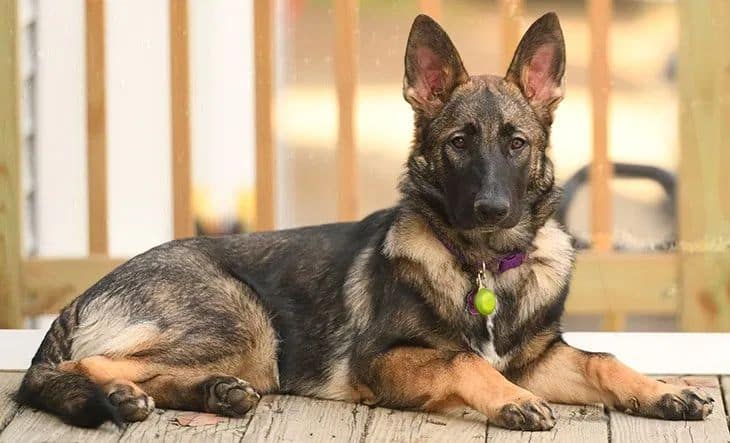Factors To Consider Before Purchasing a Sable German Shepherd?
German shepherd dogs are the best breed, especially sable German shepherd puppies. They are loyal, entertaining, and loving to own. A sable German shepherd can be found in an animal shelter, but they are uncommon. If you want to find one of these puppies, you may have to go to a reputable breeder. Before bringing a sable German Shepherd home, it is advised to understand everything there is to know about them, regardless of how experienced an owner you are.
- What Is A Sable German Shepherd?
- Sable German Shepherd History
- Sable German Shepherd Appearance
- Sable German Shepherd Maintenance and Grooming
- Sable German Shepherd Activity Level
- Sable German Shepherd Dietary Needs
- Sable German Shepherd Training
- Sable German Shepherd Health
- Sable German Shepherd Popular Names
- FAQs
What Is A Sable German Shepherd?
The sable The German shepherd is not a crossbred dog, but rather a recognized variant within the breed, therefore the dog retains all of the benefits of a purebred puppy. Surprisingly, sable is the original color of the German shepherd breed. It is the only variety of the German shepherd that has the same hue as the breed’s founder. The original German Shepherds were thought to be sable-colored, and this color changed constantly during the dog’s life. Despite their reputation as ferocious dogs who bite at the least provocation, German Shepherds are one of the best dogs you could wish for. They are a highly intelligent breed that is easy to train, fun-loving, and people-oriented.
Sable German Shepherd History
To understand the origins of the Sable German Shepherds, we must first understand the origins of the German Shepherd. Von Stephanitz first noticed the German Shepherd at a dog show and felt that this breed was the ideal standard for a working dog. He named one of these dogs “Horand” and founded the “Verein für Deutsche Schäferhunde,” or Society for the German Shepherd Dog.
Horand was the first German Shepherd breed standard, and he was bred among dogs of similar look to produce German Shepherd litters. They are believed to have first arrived in the United States in 1906, and the AKC recognized them in 1908.
Sable German Shepherd Appearance
Except for their unusually colored coat, sable German shepherds resemble most other German shepherd dogs.
German shepherds are a sizable breed. The males should be between 75 and 95 pounds in weight and up to 26 inches tall.
Females are slightly smaller than males. They typically weigh between 55 and 75 pounds and are no taller than 24 inches.
Their heads have a long, square muzzle and a rounded appearance. They appear larger than they are thanks to their lengthy necks and alert, upright ears.
The majority of German shepherds have black and red or tan and black coats. Their predominant hue is typically a lighter shade of brown, with a black face mask and black markings that frequently resemble saddles on their back.
There are also pure black, pure white, liver, silver, blue, panda, and, of course, sable color varieties.
Although the actual color combinations are more varied and the sable pattern could be any combination of tan, black, brown, or red, the term “sable” is primarily used in the United States; in other countries, such as Germany, these dogs are frequently referred to as “grey.” Sable basically means the dog has mostly lighter-colored hair with black tips, which can make the dog appear grey or mottled.
Sable German Shepherd Maintenance and Grooming
Sable German Shepherds shed a lot and have two coats. However, regular brushing keeps their loose hairs under control. These dogs shed twice a year, which implies that during those times they shed significantly more heavily than usual. If you are set on obtaining this breed of dog but have allergies, you can choose one with a medium-length coat to reduce the amount of shedding and brushing you would have to perform each week. However, some Sable German Shepherds have long coats.
Sable German Shepherd Activity Level
Energy Level Due to their high levels of playfulness and energy, Sable German shepherds require a lot of mental and physical activity to thrive.
They often serve well as working animals for this additional purpose. They are physically and mentally stimulated while working, which enables them to finish these difficult jobs. These highly motivated dogs are attracted to pleasing their handlers.
Sable German shepherds should have between 60 and 90 minutes of activity per day, ideally split up into at least two separate sessions. When they are puppies, this should be a little bit less.
Especially with large dog breeds, there is always a chance of over-exercising puppies.
A puppy should, in general, be exercised daily for five minutes for each month of its age until it is an adult. German shepherds mature at a young age of about 18 months.
Sable German Shepherd Dietary Needs
Some Sable German Shepherds like eating, while others are picky. This means you are responsible for ensuring that your dog does not get too thin, overly fat, or bloat, which is a potentially fatal condition.
Smaller, more frequent meals spaced throughout the day can usually help. It also helps to acquire the correct type of dog food for your greatest friend so he doesn’t overeat or go without the calories he requires.
An active adult Sable German Shepherd requires between 1,750 and 2,100 calories per day, depending on its weight, according to the National Academies’ science-based recommendations on a dog’s dietary needs. Each meal should include enough calories to cover its percentage of the total caloric intake.
Sable German Shepherd Training
Sable German Shepherds are extremely bright dogs that are simple to train. They should be trained beginning at a very young age, and you must always use reward-based training methods. This can involve giving them vocal compliments and tasty treats to let them know they are doing a good job.
Because German Shepherds might occasionally be a little stubborn, you should never beat or punish them. Additionally, if you give them plenty of time to work out before you decide to hold a training session, they’ll perform much better. They make excellent detectives, so concealing treats and having them find them is a lot of fun to play!
Sable German Shepherd Health
Sable German Shepherds are just as prone to health problems as their colleagues with other coat colors in the German Shepherd breed.
It is important to remember that the breed as a whole maintains a healthy condition.
The vast majority of responsible breeders take steps to guarantee that the dogs they sell are substantially free of hereditary conditions that could affect them.
It’s crucial to recognize that it’s not always possible to completely avert these problems.
Due to their large stature, German Shepherds are more prone to developing degenerative myelopathy, a progressive degradation of the spinal cord, as well as a variety of joint diseases, including hip and elbow dysplasia.
Sable German Shepherd Popular Names
- Chestnut
- Bailey
- Bear
- Brandy
- Butterscotch
- Moose
- Bowser
- Ginger
- Paddy
FAQs
What is the difference between a Sable German Shepherd and a regular German Shepherd?
Their fur is the only thing that differs. The more common German Shepherds are black and tan, however, the Sable German Shepherds often have multicolored fur strands with black tips due to genetic variances. The Sable German Shepherd is thought to be the one that most closely resembles the original German Shepherd.
What is bad about German shepherds?
German shepherds tend to be wary of everyone, which can make them act unduly possessive and territorial.
Although proper socialization might lessen this personality feature, likely, they will likely always have some degree of it.
Are German shepherds good family dogs?
German shepherds make great pets for an active household with the correct training and socialization. They will be devoted, submissive, and guardians.
They get along well with kids, though young ones should always be watched around dogs, no matter the breed or how accustomed they are to them. Even when kids are around dogs they have grown up with and are familiar with, accidents can happen.

Hey, I’m Caroline, and I’m all about bulldog love, travel, and lending a helping hand to shelter pals. Writing about dogs for five years has let me share the magic of their stories and the world of pet care. My heart? It belongs to Bella, my amazing bulldog sidekick. Together, we’re off on adventures, spreading kindness, and making shelter life brighter. Join us in celebrating the joy of dogs and making a difference!






